
Ecommerce SMS Marketing Examples and Best Practices
SMS marketing is the strategy of using text messages to deliver promotional SMS, updates, and connect with customers. While it may sound simple, the impact of e-commerce SMS marketing in the e-commerce world is crucial. With open rates as high as 98%, SMS messages cut through the noise of crowded inboxes and offer a direct line to your customers' pockets. In a world where attention is the most valuable currency, the immediacy and intimacy of a text message can make all the difference for your online store.
Imagine being able to send personalised offers, flash sales, and shipping updates directly to your customers' phones, creating a sense of urgency and excitement. This is the power of SMS marketing for e-commerce. But it's not just bulk messaging. It's about building relationships, fostering loyalty, and driving sales by crafting targeted, personalised campaigns.
In this guide, we'll delve into the world of e-commerce SMS marketing, sharing real-world examples, best practices, and tips to help you leverage this powerful tool to boost your online business.
Why your e-commerce business needs an SMS marketing strategy
In the fast-paced world of e-commerce, where customer expectations are constantly evolving, SMS marketing emerges as a game-changer. Here's why integrating SMS into your marketing strategy is not just an option, but a necessity:
Unlike emails, which can wait in inboxes for hours or even days, SMS messages are delivered instantly. This allows for real-time communication, especially important for customer queries or support tickets. For example, a client with an urgent question about their order can receive a prompt response via SMS, leading to a smoother shopping experience and increased client satisfaction.
While email marketing relies on internet connectivity, SMS messages can reach customers even in areas with limited or no internet access. Studies have consistently shown that SMS messages boost higher open and response rates compared to email. According to research by Gartner, open rates can reach a staggering 98%, with response rates averaging 45%.
Compared to cold calls, which can be disruptive and unwelcome, text messages offer a less intrusive way to connect with customers. Moreover, unlike marketing emails, which often end up in spam folders, SMS land directly in the recipient's main inbox, increasing the chances of engagement.
SMS marketing campaigns are often more cost-effective than traditional marketing channels like print advertising or direct mail.
15+ examples of e-commerce SMS marketing messages
SMS allows e-commerce businesses to connect with their customers in a concise and impactful way. However, crafting effective text messages requires careful thought and adherence to the 160-character limit. Here are some examples to inspire your campaigns.
Welcome texts
The first SMS you send to a new subscriber sets the tone for your relationship. Make it warm, welcoming, and informative:


Product promotions
E-commerce SMS marketing is a great way to promote new and existing products to your customer base. Here are a few examples of promotional SMS messages that can effectively showcase your offerings:
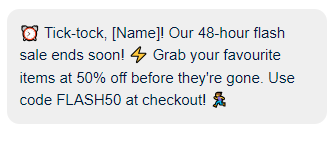
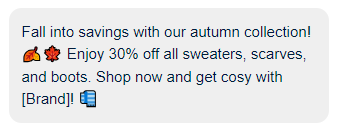
Abandoned cart reminders
A gentle reminder can be all it takes to turn an abandoned cart into a completed purchase. Here are two SMS examples that strike the right balance of urgency and helpfulness:
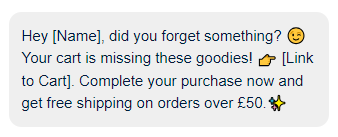
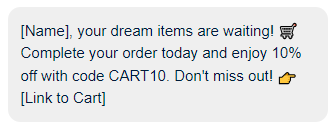
Special offers
Everyone loves a good deal, and SMS is the perfect channel to deliver those irresistible offers right into your customers' hands.
The Flash Sale

The BOGO Deal
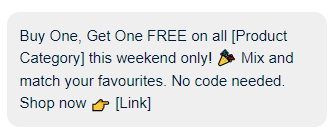
Flash sales
These types of promotional SMSs are all about creating a sense of urgency and exclusivity, and SMS is the perfect channel for delivering that jolt of excitement. Here are two examples that tap into FOMO (fear of missing out) and reward your loyal subscribers:
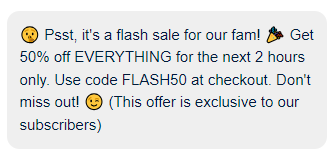
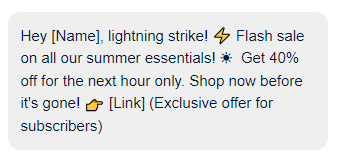
Coupons
SMS coupons are a powerful way to incentivize customers and drive sales. Here's an example of an SMS coupon:
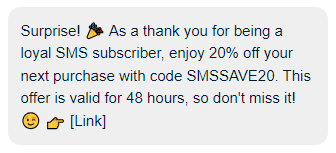
General announcements
SMS marketing is an effective way to inform customers about important updates, new offerings, and other relevant announcements. Here are a few sample announcements that could be sent via SMS:
New Payment Method
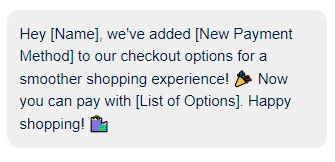
Website Relaunch
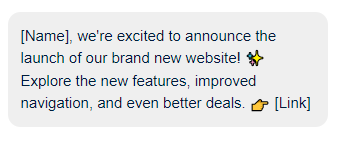
Brand Collaboration
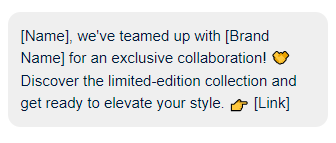
Delivery Delays
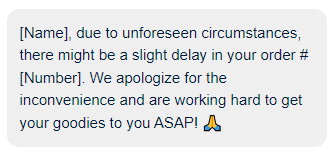
Holiday Wishes
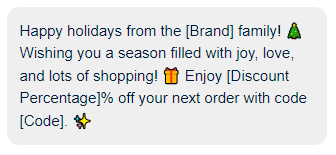
Order status and delivery updates
Keeping customers informed about the status of their orders and deliveries is crucial for providing a seamless and satisfactory shopping experience. Here's an example each of an order confirmation text and a delivery status update:
Order Confirmation
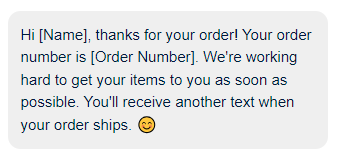
Delivery Status Update

OTPs
One-time passwords (OTPs) sent via SMS are a secure way to verify transactions and prevent unauthorized access. Here are a couple of examples of SMS messages containing OTPs:
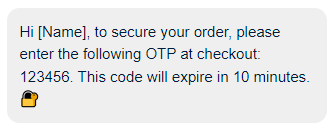
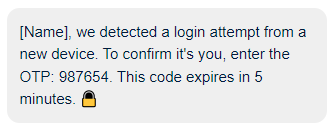
Thank you messages
A sincere thank you message can go a long way in fostering customer loyalty and building a lasting relationship with your e-commerce store:
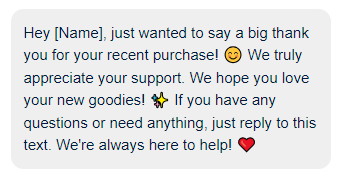
Feedback surveys
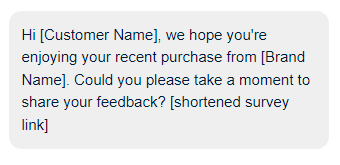
This feedback request is concise yet inviting, encouraging the customer to share their thoughts and experiences. By highlighting that their opinion matters, it creates a sense of value and appreciation for the customer's input.
Some tips to get the most out of your SMS marketing campaigns
E-commerce SMS marketing, when done right, can be a game-changer for your business. But to truly maximise its potential, here are some tips to keep in mind.
Define your target audience
Imagine sending a flash sale announcement for baby products to existing customers who have never purchased anything from your baby category. It's unlikely to resonate and may even annoy them. However, sending the same message to a segment of new parents or customers who have previously browsed or purchased baby items is much more likely to generate interest and sales.
Here are some key ways to segment your audience for e-commerce SMS marketing:
- Age, gender, location, income level, etc.
- Past purchases, frequency of purchases, average order value, etc.
- Products viewed, categories browsed, abandoned carts, etc.
- SMS open rates, click-through rates, response rates, etc.
- New subscribers, loyal customers, lapsed customers, etc.
Remember, the goal of market segmentation is not just to divide your audience but to understand them better so you can communicate with them more effectively.
Don’t underestimate the power of strong SMS copy
In e-commerce SMS marketing, every character counts. With a limited space to capture attention and convey your message, crafting a strong text copy is essential. Here's how to make your messages concise, precise, sharp, and catchy:
- Use clear, simple language and avoid unnecessary words. Remember, you only have 160 characters to work with.
- Use strong verbs and specific details to create a clear picture in the recipient's mind.
- Use a tone of voice that matches your brand.
- Use humor, wordplay, or creative language to make your messages stand out.
Here are some examples of strong SMS copy:
|
Weak ? |
Strong ? |
|
Check out our new sale. |
Flash Sale! ⚡ 50% off everything today only. Use code FLASH50. |
|
We have a special offer for you. |
You're VIP! ? Enjoy 30% off your next purchase with code VIP30. |
|
Don't forget your abandoned cart. |
Your cart is missing you! ❤️ Complete your order now and get 10% off. |
Tip: Test different SMS variations to see what works best for your audience. Use A/B testing to compare different subject lines, calls to action, and message lengths.
Use strong CTAs
Every SMS message you send should have a clear purpose and a strong call to action (CTA) to guide your customers towards the desired outcome. Whether you want them to shop, subscribe, or provide feedback, a well-crafted CTA can make all the difference.
What makes a strong CTA?
- Tell your customers exactly what you want them to do by using action-oriented verbs such as "Buy," "Click," "Subscribe," or "Reply."
- Tie the CTA to a specific message and offer, creating a sense of urgency or exclusivity.
- Give a direct link or simple instructions on how to act.
- Place the CTA at the end of the post to maximise visibility.
Remember, every SMS message is an opportunity to connect with your audience and encourage them to take the next step in their journey with your company.
Time your texts well
Sending messages at the right time can significantly impact open rates, engagement, and overall campaign success. However, it's equally important to respect your subscribers' time and avoid sending messages at inconvenient hours.
Here are some general guidelines for SMS timing:
- 10 AM to 8 PM local time is generally considered a safe window for sending promotional messages.
- Lunchtime (12 PM to 2 PM) can be a good time to catch people when they're more relaxed and likely to engage with your message.
- The early evening (6 PM to 8 PM) can also be effective as people wind down from their day.
Some people appreciate weekend deals, while others prefer not to be bothered by marketing messages on their days off. Test different times to see what works best for your audience.
Stay compliant with general SMS marketing regulations
Never send SMS marketing messages to customers without their permission. This means obtaining their express written consent, typically through an opt-in form on your website or a keyword confirmation. Clearly communicate the types of messages they will receive and how often.
In many countries, there are national or regional Do-Not-Call (DNC) registries where individuals can register their phone numbers to opt out of receiving telemarketing calls and, in some cases, text messages. Before launching an SMS campaign, check the official DNC registry to ensure you're not contacting anyone who has registered.
Every promotional text message you send should include clear instructions on how the receiver can opt out of messages. This is typically done by replying with a keyword like "STOP" or "UNSUBSCRIBE." Make the opt-out process simple and hassle-free.
State opt-out options clearly
Giving your subscribers the freedom to opt out of your e-commerce SMS marketing campaigns is not only a legal requirement but also a fundamental aspect of respectful communication. Making the opt-out process clear and simple is crucial for maintaining a positive relationship with your audience. Here's how to do it:
- Add a simple instruction at the end of each message, such as: "Reply STOP to unsubscribe”, "Text STOP to opt out". "To unsubscribe, text END".
- Avoid using confusing jargon or overly complex instructions.
- Don't bury your opt-out instructions in the middle of your message.
- When a subscriber chooses to opt out, process their request immediately.
- Consider offering multiple ways for subscribers to opt out.
Proving clear and accessible opt-out options build trust and credibility for your brand, leading to a more engaged and loyal audience.
Personalise each message
While bulk texting and SMS automation are valuable tools, personalisation can take your e-commerce SMS marketing to the next level. By tailoring messages to individual preferences and behaviours, you create a more engaging and relevant experience for your customers.
Ways to personalise your texts:
- Address your customers by name to make the message more personal.
- Suggest products or offers based on customers' previous purchases or browsing history.
- Celebrate special occasions with personalised discounts or offers.
- Send promotions relevant to the customer's location.
- Create different messages for different customer groups based on demographics, interests, or purchase behaviour.
- Use text abbreviations to make your messages more concise and engaging, ensuring quick readability while maintaining a personal touch
Integration with other marketing channels
E-commerce SMS marketing doesn't exist in a vacuum. To maximise its potential, it's essential to integrate it with your other marketing channels, creating a seamless omnichannel experience for your customers.
This matters because of:
- Using SMS along with email, social media, and other channels, you can reinforce your marketing messages and increase their overall impact.
- Each channel reaches different segments of your audience, so integrating SMS allows you to reach customers who may not be active on other platforms.
- By collecting data across multiple channels, you can build a more comprehensive profile of your customers and send even more personalized SMS messages.
- A seamless omnichannel experience makes it easy for customers to interact with your brand on their preferred channels, leading to increased satisfaction and loyalty.
Integrate your SMS marketing platform with your CRM to sync customer data and create more targeted campaigns.
Leverage technology
While SMS might seem like an old-school marketing channel, it's constantly evolving and embracing new technologies.
Text automation is a game-changer in e-commerce SMS marketing. By automating repetitive tasks, you can save time, reduce errors, and scale your campaigns efficiently. Consider using automation for:
- Trigger welcome messages once a customer subscribes to your list.
- Automatically send reminders to customers who leave items in their cart.
- Send automated notifications to inform customers of their order status.
- Create a series of automated messages that nurture leads and guide them through the customer journey.
Rich communication services are the next generation of messaging, offering a richer and more interactive experience than traditional SMS. With RCS, you can send high-quality images and videos, create branded messages, and include interactive elements like buttons and carousels.
How to get started with SMS marketing for e-commerce
Ready to discover the power of bulk messaging for your e-commerce business? Here's a step-by-step guide to help you get started and make the most of this powerful channel.
1. Build a subscriber list
A robust subscriber list is the bedrock of any effective SMS marketing campaign. But how do you attract customers?
Building a subscriber list involves actively encouraging your target audience to opt in to receive your SMS messages. This is done through various strategies, both online and offline.
To make your SMS even more enticing, offer incentives and exclusive benefits to subscribers, such as:
- Offer a welcome discount or ongoing special offers to subscribers.
- Give subscribers early access to flash sales or new product launches.
- Share behind-the-scenes peeks, sneak previews, or other exclusive content with your SMS marketing list.
- Send product recommendations based on subscribers' browsing or purchase history.
- Offer rewards or points for SMS subscribers who make repeat purchases.
Remember, the key is to make it easy and enticing for customers to join and always provide clear value in exchange for their phone numbers.
2. Choose an SMS provider
Selecting the right SMS provider is crucial for the success of your e-commerce SMS marketing strategy. The provider you choose will be the engine that powers your campaigns, so it's important to select one that aligns with your business needs and budget.
Look for a platform with an intuitive interface and user-friendly features that make it easy to create, schedule, and manage your SMS campaigns. Consider the features that are important to your business, such as automation, segmentation, personalisation, A/B testing, and analytics. Ensure the platform integrates seamlessly with your e-commerce platform or CRM to streamline your workflow and data management. Compare pricing plans from different providers to find one that fits your budget.
For a comprehensive and effective e-commerce SMS marketing solution that integrates seamlessly with your operations, consider Decision Telecom. Our platform empowers you to engage customers across SMS, WhatsApp, Viber, and other channels, delivering a unified and personalised experience that drives results.
Contact us today to learn more about our omnichannel messaging solutions and how we can help you achieve your business goals.
3. Plan your SMS campaign
Once you've built your subscriber list and chosen an SMS provider, it's time to plan your first campaign. A well-thought-out plan ensures your efforts are targeted, effective, and measurable.
Remember the principles of strong SMS copy. Keep it concise, compelling, and personalised. Craft a clear message that highlights the value proposition of your offer or announcement. Use strong verbs, numbers, and symbols to grab attention, and always include a clear CTA.
Ensure you have all the necessary assets ready, including product images, landing pages, discount codes, and tracking links. Define Key Performance Indicators (KPIs) to measure the success of your campaign.
Divide your subscriber list into distinct segments based on demographics, purchase history, or interests. This allows you to tailor your message and offer to each segment, increasing relevance and customer engagement.
4. Start texting
Before hitting send, meticulously review your SMS message copy for any typos, grammatical errors, or unclear information. Ensure your CTAs are compelling and your links are working correctly. Test the message on different devices to make sure it renders properly.
If this is your first SMS message campaign, consider starting with a small segment of your list to gauge the response and gather initial feedback. This allows you to refine your approach before sending it to your entire audience.
Don't be afraid to ask your subscribers for feedback on your SMS campaigns. This can be done through a simple survey or by encouraging them to reply to your messages with their thoughts. Valuable feedback can help you tailor future campaigns to better meet their needs and preferences.
Remember, your first SMS campaign is just the beginning. E-commerce SMS marketing is an ongoing process of testing, learning, and refining your approach. By starting small, monitoring your results, and gathering feedback, you can continuously improve your campaigns and achieve greater success over time.
Conclusion
SMS marketing messages have proven to be an invaluable tool for e-commerce brands, offering a direct and efficient communication channel to connect with customers. Throughout this article, we've explored various examples and best practices that showcase the versatility and effectiveness of SMS campaigns.
From welcome messages and product promotions to abandoned cart reminders and delivery updates, text messages enable businesses to engage with customers at every stage of the buyer's journey. By leveraging the high open and response rates of SMS, e-commerce companies can cut through the noise and deliver personalized, timely messages that drive engagement, foster customer loyalty, and ultimately boost sales.
Remember, successful e-commerce SMS marketing requires a strategic approach. Build a quality subscriber list, choose the right SMS provider, craft compelling messages, segment your audience, and track your results. By following these best practices, you can unlock the full potential of SMS and achieve remarkable results for your business.
If you're looking for reliable and scalable SMS marketing software, look no further than Decision Telecom's SMS API. Our API seamlessly integrates with your e-commerce platform, allowing you to send bulk messages, automate campaigns, and track performance with ease.
Don't miss the opportunity to supercharge your e-commerce sales with SMS strategy. Contact Decision Telecom today to learn more and get started.


